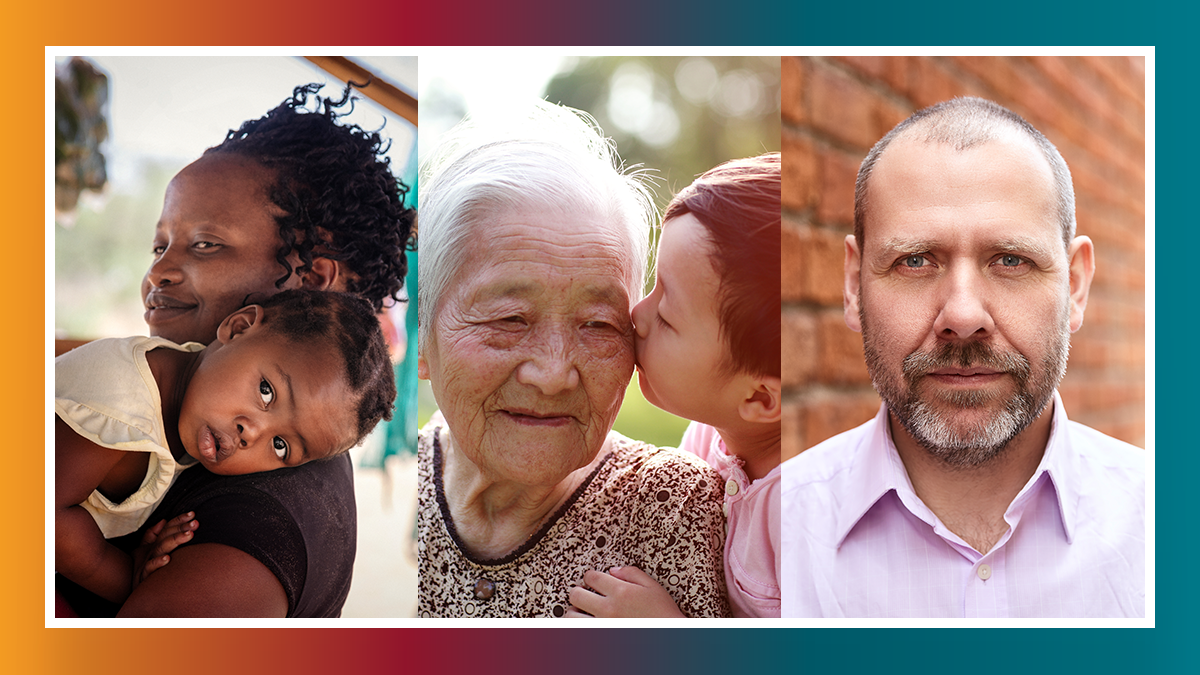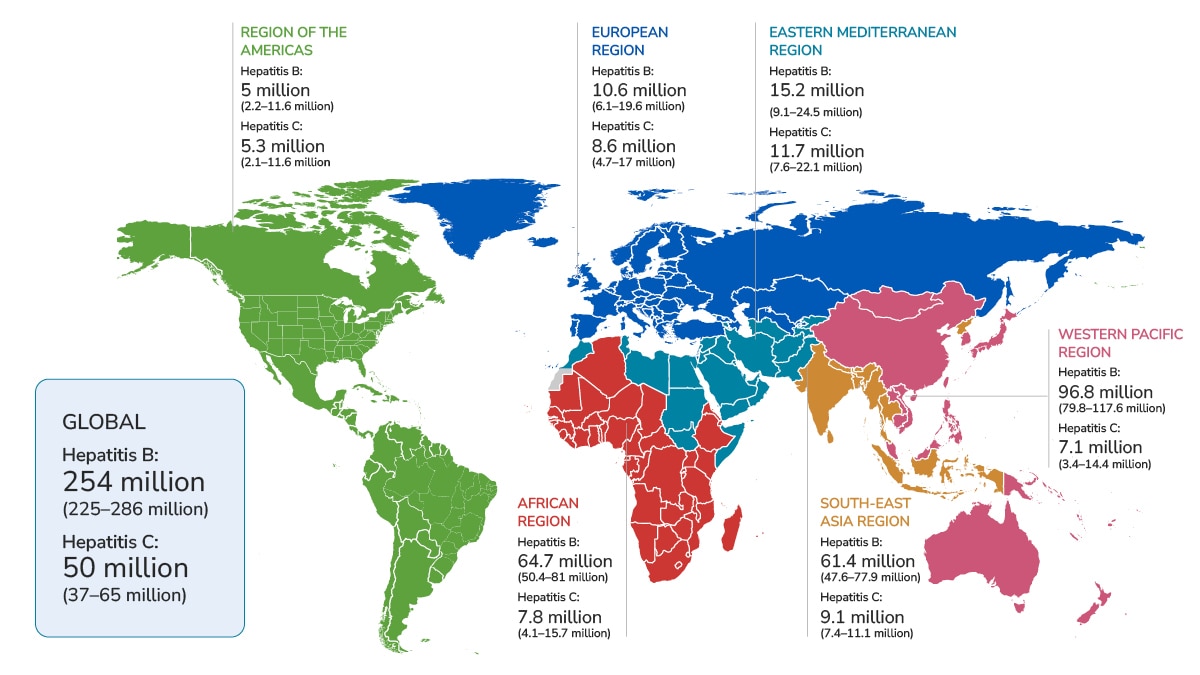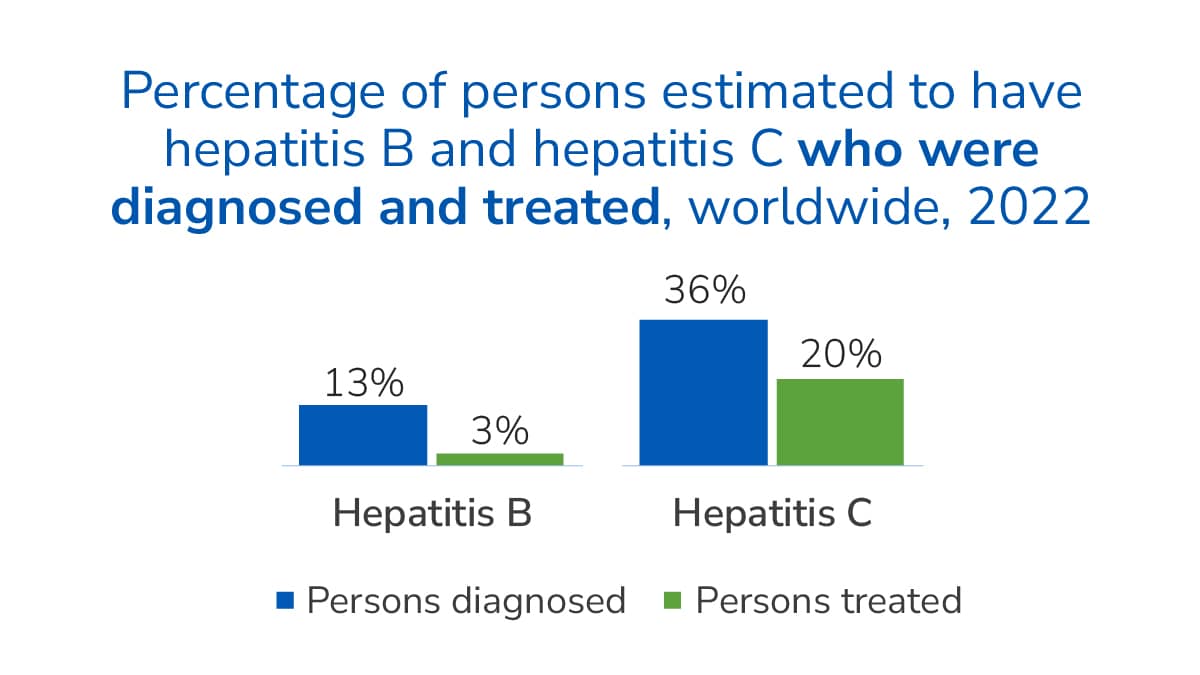At a glance
Viral hepatitis affects more than 300 million people globally. Most people are not diagnosed or getting the treatment they need. Each day, 3,500 people die from liver disease caused by viral hepatitis worldwide. Safe and effective vaccines, prevention, and treatments can avert liver disease and cancer caused by viral hepatitis. Increasing intervention and prevention methods can save money and lives.

Viral hepatitis worldwide
According to estimates that during 20221:
- 1.2 million people were newly infected with hepatitis B virus (HBV).
- 1 million people were newly infected with hepatitis C virus (HCV).
- Approximately 254 million people have chronic hepatitis B.
- Nearly 50 million people have chronic hepatitis C.
- Chronic hepatitis B and chronic hepatitis C cause 1.3 million deaths each year due to liver disease and cancer.
Did you know?

World Health Organization — Global hepatitis report 2024: Action for access in low- and middle-income countries. Geneva: World Health Organization; 2024.
Current status of prevention and treatment
There are safe and effective vaccines against hepatitis A and hepatitis B, treatment for hepatitis B, and curative treatment for hepatitis C.
Hepatitis A prevention
Hepatitis A vaccine (HepA) has the potential to control outbreaks and prevent disease and death. In 2024, however, HepA vaccine was only used in 50 countries. International travel increases risk of exposure to and infection with hepatitis A if unvaccinated.
Learn more about hepatitis A prevention and control.
Hepatitis B prevention
Universal hepatitis B vaccination (HepB) of all infants beginning at birth provides a critical safeguard and prevents infection among infants born to mothers with HBV infection. In 2024, however, only 45% of infants2 received hepatitis B birth dose vaccine, and 84% of children globally received three doses of HepB vaccine.
Learn more about hepatitis B prevention and control, and what CDC is doing to prevent the primary source of global chronic hepatitis B.
Hepatitis B and hepatitis C treatment
Safe and effective treatments can prevent liver disease and liver cancer among people with hepatitis B and cure those living with hepatitis C. Most people with these infections, however, remain undiagnosed and untreated.

World Health Organization — Global hepatitis report 2024: Action for access in low- and middle-income countries. Geneva: World Health Organization; 2024.
Learn more about how CDC is working globally to eliminate global death and disease caused by viral hepatitis.
Benefits of global hepatitis B elimination
Issue
- Without increased coverage of vaccination, diagnosis, and treatment, hepatitis B mortality is estimated to cost $784 billion globally in lost productivity during 2022–2050.3
Solutions and benefits
- Increasing coverage in vaccination, testing, and treatment can help lower this economic burden.
- As a result of US investment in preventing and controlling hepatitis B in other countries, since 2000, almost 900,000 hepatitis B virus infections and 65,635 hepatitis B related deaths were prevented in the United States leading to an estimated $7.8 billion in savings by 2070.3
- Scaling up vaccination of hepatitis B to 90% and treatment to 80% globally could avert 26 million infections and 9 million hepatitis B-attributable deaths during 2022–2050.3
Benefits of global hepatitis C elimination
Issue
- Most people with hepatitis C go undiagnosed and untreated, yet safe and affordable treatments are available and cure over 95% of people diagnosed with hepatitis C.
- Preventing premature deaths and increasing workforce participation among people who are cured could provide substantial economic benefits.
Solutions and benefits
- The economic benefit generated from the efforts above is estimated at $22 billion by 20304.
- Scaling up hepatitis C testing to 90% and treatment to 80% are estimated to potentially prevent 2.1 million hepatitis C-related deaths and 10 million new infections globally.
Resources
CDC
World Health Organization
- World Health Organization. Global hepatitis report 2024: action for access in low- and middle-income countries
- World Health Organization: Hepatitis B Vaccination Coverage.
- Hutton DW, Toy M, Yang D, et al. Modelling the potential impact of global hepatitis B vaccination on the burden of chronic hepatitis B in the United States. Journal of Viral Hepatitis.2024; 31: 614-622.
- Scott N, Kuschel C, Pedrana A, Schroeder S, Howell J, Thompson A, Wilson DP, Hellard M. A model of the economic benefits of global hepatitis C elimination: an investment case. Lancet Gastroenterol Hepatol. 2020 Oct;5(10):940–947.
- Seaman CP, Luong P, Xiao Y, et al. A global investment case for hepatitis B elimination: a modeling study. Lancet Gastroenterol Hepatol. 2023;8:932–942.
